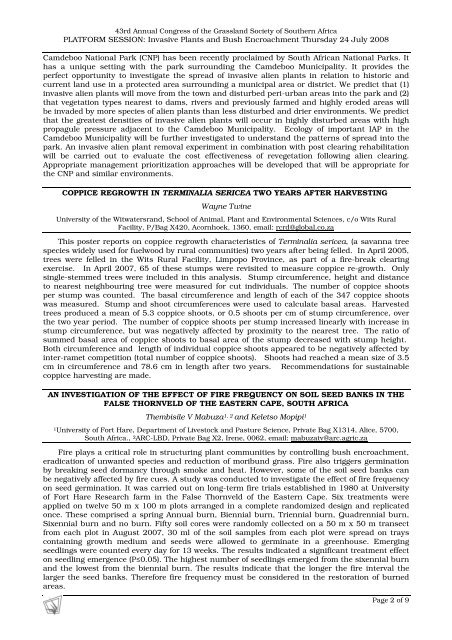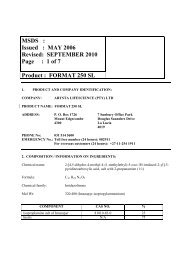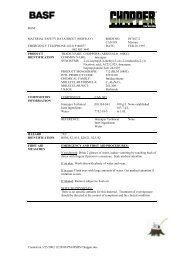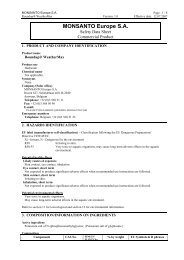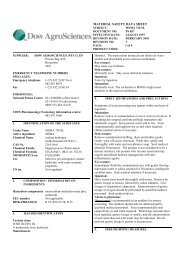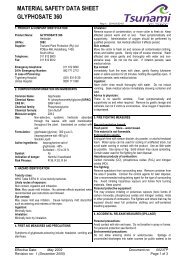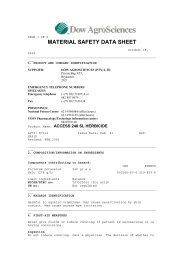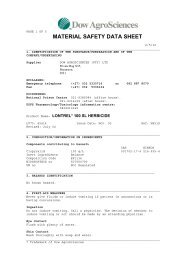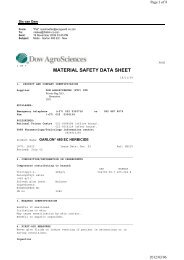Invasive Plants and Bush Encroachment
Invasive Plants and Bush Encroachment
Invasive Plants and Bush Encroachment
Create successful ePaper yourself
Turn your PDF publications into a flip-book with our unique Google optimized e-Paper software.
43rd Annual Congress of the Grassl<strong>and</strong> Society of Southern Africa<br />
PLATFORM SESSION: <strong>Invasive</strong> <strong>Plants</strong> <strong>and</strong> <strong>Bush</strong> <strong>Encroachment</strong> Thursday 24 July 2008<br />
Camdeboo National Park (CNP) has been recently proclaimed by South African National Parks. It<br />
has a unique setting with the park surrounding the Camdeboo Municipality. It provides the<br />
perfect opportunity to investigate the spread of invasive alien plants in relation to historic <strong>and</strong><br />
current l<strong>and</strong> use in a protected area surrounding a municipal area or district. We predict that (1)<br />
invasive alien plants will move from the town <strong>and</strong> disturbed peri-urban areas into the park <strong>and</strong> (2)<br />
that vegetation types nearest to dams, rivers <strong>and</strong> previously farmed <strong>and</strong> highly eroded areas will<br />
be invaded by more species of alien plants than less disturbed <strong>and</strong> drier environments. We predict<br />
that the greatest densities of invasive alien plants will occur in highly disturbed areas with high<br />
propagule pressure adjacent to the Camdeboo Municipality. Ecology of important IAP in the<br />
Camdeboo Municipality will be further investigated to underst<strong>and</strong> the patterns of spread into the<br />
park. An invasive alien plant removal experiment in combination with post clearing rehabilitation<br />
will be carried out to evaluate the cost effectiveness of revegetation following alien clearing.<br />
Appropriate management prioritization approaches will be developed that will be appropriate for<br />
the CNP <strong>and</strong> similar environments.<br />
COPPICE REGROWTH IN TERMINALIA SERICEA TWO YEARS AFTER HARVESTING<br />
Wayne Twine<br />
University of the Witwatersr<strong>and</strong>, School of Animal, Plant <strong>and</strong> Environmental Sciences, c/o Wits Rural<br />
Facility, P/Bag X420, Acornhoek, 1360, email: rcrd@global.co.za<br />
This poster reports on coppice regrowth characteristics of Terminalia sericea, (a savanna tree<br />
species widely used for fuelwood by rural communities) two years after being felled. In April 2005,<br />
trees were felled in the Wits Rural Facility, Limpopo Province, as part of a fire-break clearing<br />
exercise. In April 2007, 65 of these stumps were revisited to measure coppice re-growth. Only<br />
single-stemmed trees were included in this analysis. Stump circumference, height <strong>and</strong> distance<br />
to nearest neighbouring tree were measured for cut individuals. The number of coppice shoots<br />
per stump was counted. The basal circumference <strong>and</strong> length of each of the 347 coppice shoots<br />
was measured. Stump <strong>and</strong> shoot circumferences were used to calculate basal areas. Harvested<br />
trees produced a mean of 5.3 coppice shoots, or 0.5 shoots per cm of stump circumference, over<br />
the two year period. The number of coppice shoots per stump increased linearly with increase in<br />
stump circumference, but was negatively affected by proximity to the nearest tree. The ratio of<br />
summed basal area of coppice shoots to basal area of the stump decreased with stump height.<br />
Both circumference <strong>and</strong> length of individual coppice shoots appeared to be negatively affected by<br />
inter-ramet competition (total number of coppice shoots). Shoots had reached a mean size of 3.5<br />
cm in circumference <strong>and</strong> 78.6 cm in length after two years. Recommendations for sustainable<br />
coppice harvesting are made.<br />
AN INVESTIGATION OF THE EFFECT OF FIRE FREQUENCY ON SOIL SEED BANKS IN THE<br />
FALSE THORNVELD OF THE EASTERN CAPE, SOUTH AFRICA<br />
Thembisile V Mabuza 1, 2 <strong>and</strong> Keletso Mopipi 1<br />
1University of Fort Hare, Department of Livestock <strong>and</strong> Pasture Science, Private Bag X1314, Alice, 5700,<br />
South Africa., 2 ARC-LBD, Private Bag X2, Irene, 0062, email: mabuzatv@arc.agric.za<br />
Fire plays a critical role in structuring plant communities by controlling bush encroachment,<br />
eradication of unwanted species <strong>and</strong> reduction of moribund grass. Fire also triggers germination<br />
by breaking seed dormancy through smoke <strong>and</strong> heat. However, some of the soil seed banks can<br />
be negatively affected by fire cues. A study was conducted to investigate the effect of fire frequency<br />
on seed germination. It was carried out on long-term fire trials established in 1980 at University<br />
of Fort Hare Research farm in the False Thornveld of the Eastern Cape. Six treatments were<br />
applied on twelve 50 m x 100 m plots arranged in a complete r<strong>and</strong>omized design <strong>and</strong> replicated<br />
once. These comprised a spring Annual burn, Biennial burn, Triennial burn, Quadrennial burn,<br />
Sixennial burn <strong>and</strong> no burn. Fifty soil cores were r<strong>and</strong>omly collected on a 50 m x 50 m transect<br />
from each plot in August 2007, 30 ml of the soil samples from each plot were spread on trays<br />
containing growth medium <strong>and</strong> seeds were allowed to germinate in a greenhouse. Emerging<br />
seedlings were counted every day for 13 weeks. The results indicated a significant treatment effect<br />
on seedling emergence (P≤0.05). The highest number of seedlings emerged from the sixennial burn<br />
<strong>and</strong> the lowest from the biennial burn. The results indicate that the longer the fire interval the<br />
larger the seed banks. Therefore fire frequency must be considered in the restoration of burned<br />
areas.<br />
Page 2 of 9


